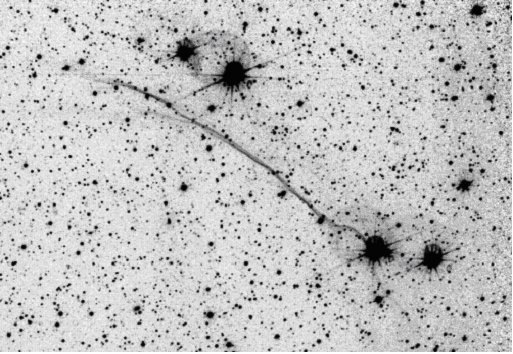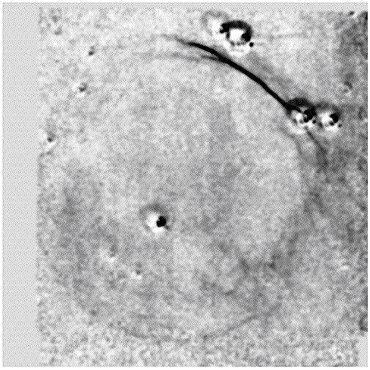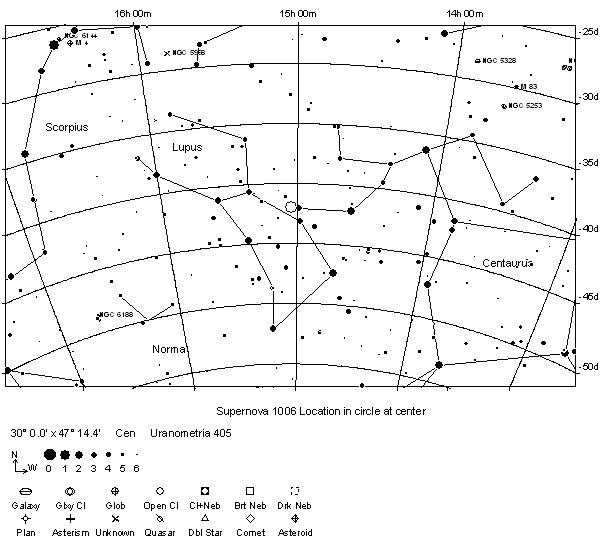
The Mysterious Supernova of 1006 AD
RA: 15h 02m, Constellation: Lupus
DEC: -41° 55' Size: 30' x 30' Distance » 2 kpc
The supernova of 1006 AD is probably the brightest stellar event in recorded history. Despite its declination of -38° in the year 1006 (-42° in J2000) numerous records of contemporary sightings of northern observers are known to exist.
Some of the ancient accountings of the event are described as follows: The ancient astrologer Ali ibn Ridwan of Cairo saw the star on May 1, 1006 “…It was large, round in shape, its size was 2 ½ - 3 times the size of Venus…, its light illuminated the horizon and twinkled a great deal…its brightness was a little more than that of the quarter of the Moon…”
Astronomers know that the brighter the object, the eye’s perception is that it appears larger. Back in those days, astronomers thought the brighter stars had perceptible disks, this being a psychological effect of the human eye.
In the Chronicles of Ibn al-Athir (13th Century): In the Year 396 A.H. (1006 AD), “at the new moon,…a star similar to Venus appeared on the left side of qibla,..its rays on the Earth were like the rays on the Moon…”
Bar Hebraeus: “In A.H. 396 (1006 AD) there appeared a star resembling Aphrodite in brightness…gave out light like the Moon…and remained 4 months and disappeared.” (“Disappeared” meant into the Sun’s glare)
European accounts: Hepidannus of St. Gall, Switzerland wrote , “ The star was visible in the extreme south.” This places a limit on how far south it must have been since it must have been above the horizon from St. Gall (latitude 47 ½ degrees north). Chinese and Japanese accounts place the new star on the present day border of the Constellations Lupus and Centaurus, thus its position can be tied down to fine limits.
The duration of time the supernova was visible from several accounts was 4 months before being lost in the Sun’s glare. After 7 months the supernova again became visible in the dawn sky between November 24 and December 22. Then again ancient accounts say it was visible for at least a year. It is possible that the star was erratically visible for up to 10 years according to the Chinese Chronicle Sung Shih, referring to a star visible in November 1006 through May 1016.
Astronomers believe from the ancient accounts that this was the brighter, more luminous Type 1a supernova with an estimated maximum apparent magnitude of m = -6.5 to -9 !! This is the light of a half Moon shrunk to the size of a star.
Using bits and pieces of historical accounts, Palomar astronomer Walter Baade searched for a possible remnant using the 48” Schmidt reflector near the Star Beta Lupi without success. (His photographic searches showed stars down to magnitude 20). It wasn’t until 1965 that a 30' circular radio shell was found by F. Gardner and D. Milne. Winkler and Laird confirmed this location as an X-ray source in 1976. Up until this time, no optical confirmation of any type of remnant was found. Such was also been the case of Tycho’s supernova and Kepler’s Supernova, where only radio emission has been observed.
In 1976, Canadian astronomer Sidney van den Bergh discovered a faint optical filament on the northwest portion of the radio remnant. He used the 4-meter telescope at the Cerro Tololo Observatory in Chile. The filament was thin and thickness varied from 1'' to 9'' across a 10' long strip. No other optical remnants have been found, except in this northwest area of the remnant. A recent image of the remnant is shown as Figure 1.

Figure 1. Optical image of northwest filament of SN 1006. Filament is 10' long. The star in the lower right intersecting the filament is SAO 225384, magnitude +8.1.
With the optical remnant identified, numerous investigations started on the SN 1006 to determine its actual size, distance and expansion velocity. It was found that the supernova was expanding at the rate of 2,600 ± 300 km/sec, its distance was estimated as 1.8 ± 0.3 kpc and proper motions of the expanding filament were measured by van den Bergh in 1988 as 0.30 ± 0.04 arc seconds/yr based upon an 11 year baseline. (This optical expansion corresponds to a expansion velocity of 2,800 km/sec). In addition, five X-Ray point sources were identified near the center of the radio/ optical remnant. As of 2002, no one object has been positively identified as a remains of the star that went supernova in 1006. No pulsar has been discovered either. As a comparison, the Crab Nebula progenitor, which resulted in a powerful pulsar, may be a rare object arising from the leftover star of a supernova. This most energetic of all pulsars may possibly be due to unique conditions of the supernova and/or the mass/chemical composition of the star at the time of the supernova event.

Figure 2. H-alpha mosaic of SN 1006. Optical portion of remnant is in upper right (northwest) portion of remnant. The remnant is 30' in diameter.
Modern studies of SN 1006 concentrate on its X-Ray profiles from orbiting satellites and radio maps. A H-alpha mosaic of the nearly circular remnant is shown as Figure 2 above.
Despite numerous investigations into the nature of SN 1006 across the entire electromagnetic spectrum, it has proved to be elusive to our understanding. Some of the unanswered questions: Why are there no other optical filaments visible ? Why hasn’t the original star that went supernova been identified?

Finder chart for SN 1006.
REFERENCES
Burnham, R., 1978, “Burnham’s Celestial Handbook”, Dover Publications, New York, p. 1117.
Long, K., Blair, W.P., 1988, An Improved Proper Motion Measurement of SN 1006, Astrophysical Journal, 333, p. 749.
Murdin, Paul and Lesley, “Supernovae”, Cambridge University Press 1985, p. 14.
van den Bergh, S., 1976, The Optical Remnant of the Lupus Supernova of 1006, Astrophysical Journal Letters, 208, L17.
Winkler, P. F., Long, K., 1997, X-Ray and Optical Imagery of the SN 1006 Remnant, Astrophysical Journal, 491, p. 829.